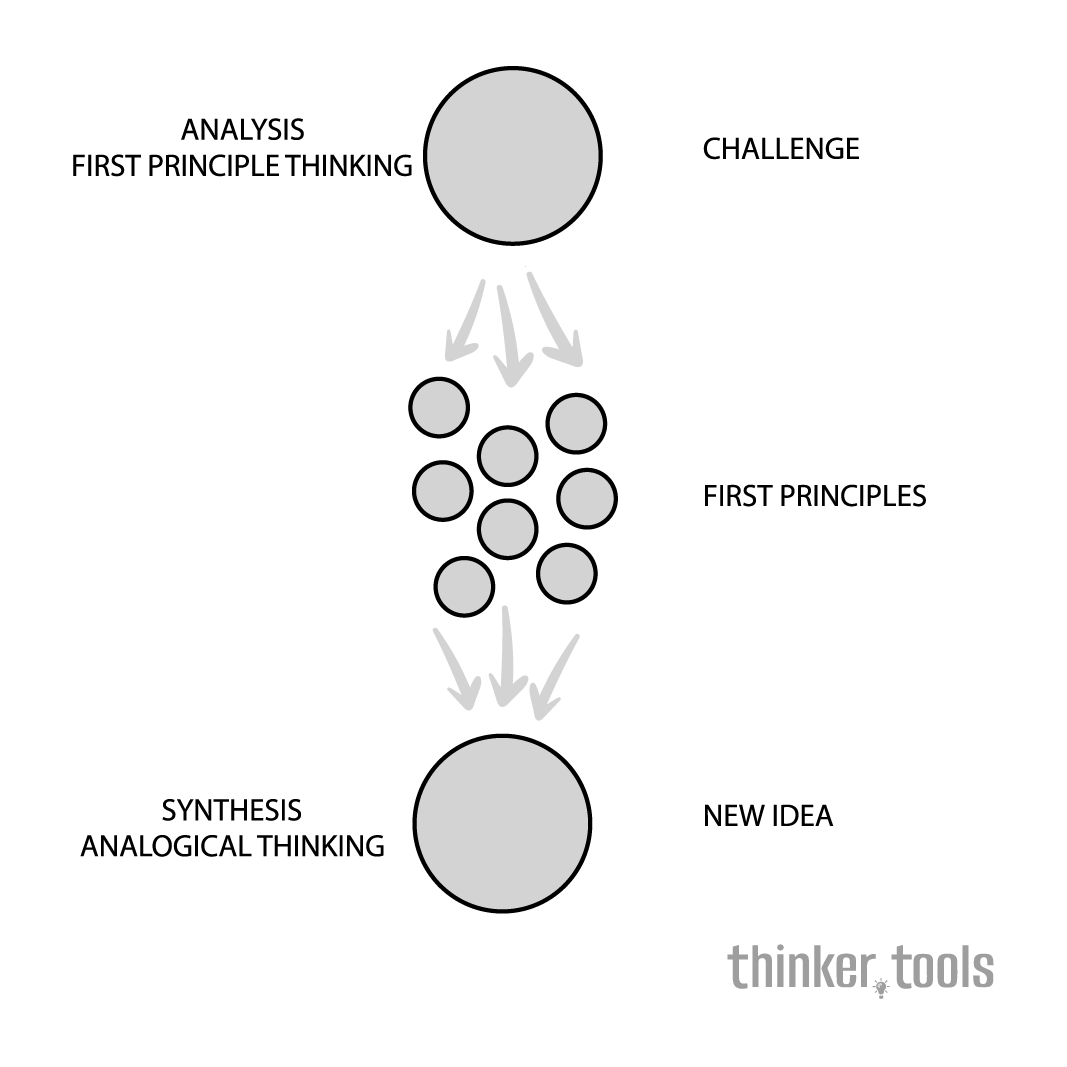
What is First Principles Thinking?
First Principles thinking is a method of reasoning that breaks down complex problems into basic elements and then reassembles them from the ground up. It's about boiling things down to the most fundamental truths and reasoning up from there. Rather than reasoning by analogy (comparing to how things are usually done), First Principles thinking questions every assumption and builds solutions based on fundamental truths. This approach allows you to see past conventional wisdom and create truly innovative solutions.
History and Origin
The concept of First Principles dates back to ancient Greek philosophy, particularly Aristotle, who defined a first principle as "the first basis from which a thing is known." In his work "Physics," Aristotle used First Principles to understand the natural world by identifying fundamental causes. The method gained renewed prominence through its use by pioneering thinkers like Johannes Kepler in astronomy and Isaac Newton in physics. In modern times, Elon Musk has popularized the approach, using it to revolutionize industries from electric vehicles to space travel by questioning basic assumptions others took for granted.
How to Use First Principles Thinking: Step by Step
Step 1: Identify and Define Your Problem
Clearly articulate what you're trying to solve:
- Be specific about the challenge
- Avoid premature solutions in your problem statement
- Focus on the outcome you want to achieve
- Example: "Reduce the cost of space travel by 10x"
Step 2: Break Down the Problem into Fundamental Parts
Deconstruct the problem to its basic components:
- List all current assumptions
- Identify what everyone "knows" to be true
- Question why things are done the current way
- Separate facts from assumptions
Step 3: Question Every Assumption
Challenge each assumption rigorously:
- Ask "Why?" repeatedly (5 Whys technique)
- "Is this really true?"
- "What evidence supports this?"
- "What if this wasn't a constraint?"
- "Why does it have to be this way?"
Step 4: Identify the Fundamental Truths
Find the bedrock truths that cannot be broken down further:
- Physical laws (gravity, thermodynamics)
- Mathematical certainties
- Biological necessities
- Economic fundamentals
- Human nature basics
Step 5: Build Up from First Principles
Create new solutions from fundamental truths:
- Start with only what you know is true
- Combine fundamentals in new ways
- Ignore how things are "usually done"
- Think like you're the first person solving this
- Be willing to create entirely new approaches
Step 6: Test and Iterate
Validate your First Principles-based solution:
- Create small experiments
- Test core assumptions
- Gather data on results
- Refine based on learning
- Scale what works
Practical Examples
SpaceX Rocket Example (Elon Musk):
- Conventional Thinking: "Rockets cost $65 million because that's what they cost"
- First Principles Breakdown:
- What are rockets made of? Aluminum alloys, titanium, copper, carbon fiber
- What's the raw material cost? About 2% of typical rocket price
- Why so expensive? Assumptions about manufacturing, supply chain, reusability
- Solution: Build rockets in-house, make them reusable, revolutionize manufacturing
- Result: 10x cost reduction in space launch
Personal Finance Example:
- Problem: "I can't save money on my salary"
- Assumptions: Need car for work, must live in expensive area, require certain lifestyle
- First Principles:
- Basic needs: Food, shelter, transportation to work
- Income is fixed at $X per month
- Rebuilt Solution: Remote work eliminates commute, move to lower cost area, cook instead of restaurants
- Result: 50% reduction in expenses without reducing quality of life
Business Model Example:
- Traditional Publishing: Authors → Publishers → Distributors → Bookstores → Readers
- First Principles:
- Authors create content
- Readers want content
- Money exchanges for value
- Amazon's Solution: Direct digital delivery, print-on-demand
- Result: 70% royalties vs 10%, instant global distribution
Education Example:
- Assumption: "Learning requires 4-year university degree"
- First Principles:
- Learning requires access to information
- Skills need practice and feedback
- Credentials signal competence
- New Solutions: Online courses, bootcamps, project portfolios, micro-credentials
- Result: 10x faster skill acquisition at 1/10th the cost
Benefits and Life Improvements
First Principles thinking delivers transformative benefits across all areas of life:
Breakthrough Innovation: By ignoring "how things are done," you can create solutions that are orders of magnitude better than existing ones.
Clear Thinking: Stripping away assumptions reveals what really matters, leading to clearer decision-making and problem-solving.
Reduced Complexity: Complex problems become manageable when broken down to fundamental components.
Cost Reduction: Questioning why things cost what they do often reveals massive savings opportunities.
Intellectual Independence: You stop accepting "common wisdom" and develop your own well-reasoned perspectives.
Creative Confidence: Understanding fundamentals gives you confidence to challenge experts and conventional approaches.
Better Learning: Grasping First Principles in any field accelerates learning by providing a framework to hang new knowledge on.
Life Design: Applied personally, First Principles helps you design a life based on what truly matters to you, not societal expectations.
Problem-Solving Power: You become able to tackle problems others consider impossible by seeing solutions they can't imagine.
Competitive Advantage: In business and career, First Principles thinking creates unique solutions competitors can't easily copy.
First Principles thinking is not just a problem-solving tool—it's a complete mental model for approaching the world. It requires courage to question what everyone "knows" and intellectual rigor to build from fundamental truths. The payoff is the ability to see solutions invisible to those trapped in conventional thinking. Whether you're trying to revolutionize an industry, solve a personal challenge, or simply understand something deeply, First Principles thinking provides the framework. In a world where most people think by analogy, those who think from First Principles have the power to reshape reality itself. Master this approach, and you join the ranks of humanity's greatest innovators and clearest thinkers.